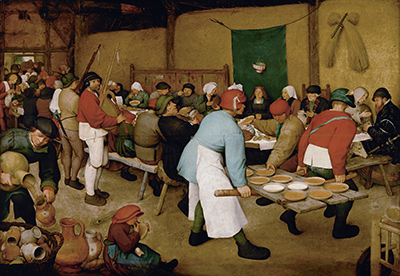Peasant Wedding was painted by Pieter Bruegel the Elder in around 1567 as an oil on panel piece. It beautifully captured his devotion to the working poor within his nation which dominate many of his most famous paintings.
It was possibly paired with the Peasant Dance, which was a similar sized painting, created around the same date. It is a wonderful, warm image which captures a snapshot of sixteenth century peasant life. Many experts have studied this picture and considered the possibility that Bruegel was making references to images such as the Last Supper or the Marriage at Cana, where Christ turned water into wine. However, they all seem to agree that Peasant Wedding is an accurate portrayal of the customs, costumes and food at a sixteenth century peasant wedding.
Again, much speculation has been made about which figure is the bridegroom but the painting seems to depict a traditional wedding. The bride, wearing the crown sits in front of the green wall-hanging not participating in the feasting. The bridegroom would not have been present until evening time and glancing at the crowd pressing into the barn and onto the threshing floor, the viewer can see that it is still daylight. Bruegel, captures every minute detail of the scene. The guests, including the well-dressed landowner, sits upon a tub, the notary appears to be in the high back-chair.
The food which was probably soup or porridge is carried to the tables on a old door and food is the main focus for the guests. Everyone would have had their own knife, even the child wears one. One of the men has a round wooden spoon tucked in his hat. The setting itself, with the straw and cereal reminds the viewer of the landscape and also of everyday toil. Beer or wine flows although no one appears inebriated in this scene unlike the Peasant Dance. Bruegel has taken a slice of history which allows the viewer to observe the festivities and intimate details of a Peasant Wedding, perhaps just as he did, many centuries before.




